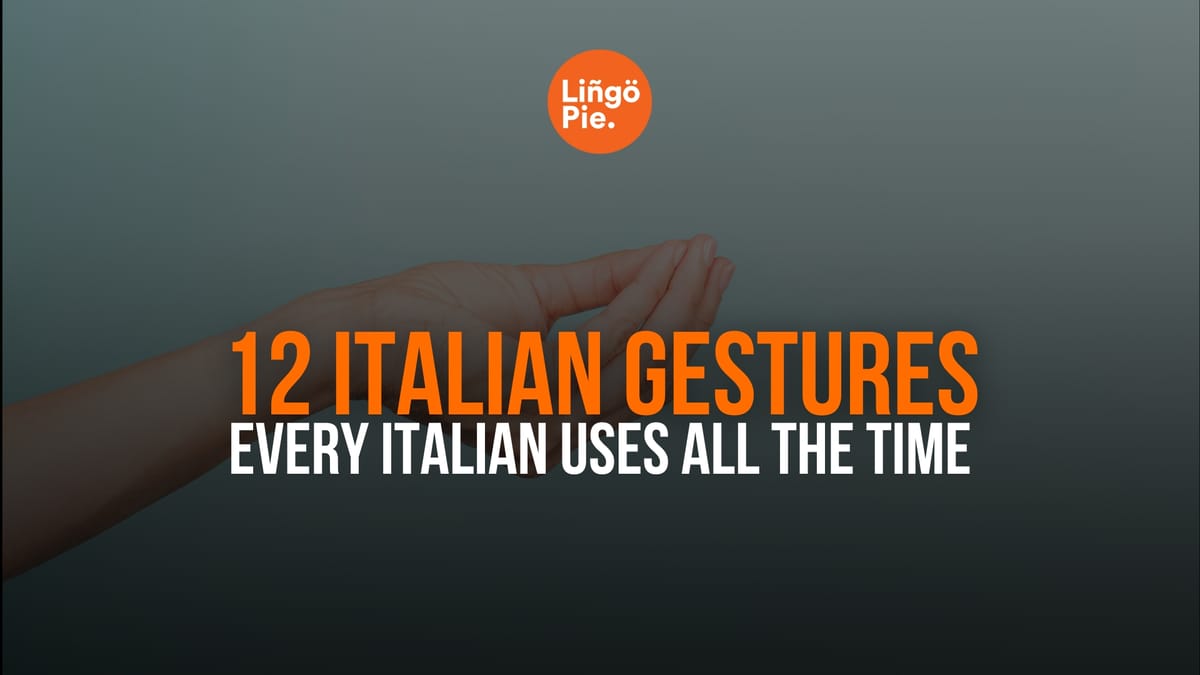When you're learning Italian, there’s a 99.9% chance you’ll realize that communication goes far beyond just words. Italian hand gestures are as important to learning the language as vocabulary and grammar. In fact, these expressive movements are deeply embedded in Italian culture, with studies suggesting Italians use approximately 250 distinct gestures during everyday conversation.
In this post, we sat down with our Italian team members to ask them about these iconic hand gestures to learn how to use them and what they actually mean. By learning these gestures, you'll communicate more effectively and gain a deeper connection to Italian culture and its expressive spirit.

What Are Italian Hand Gestures?
Italian hand gestures are specific hand movements with clear meanings in Italian culture. They work like a visual language alongside spoken Italian, helping to express emotions, emphasize points, or even replace words entirely. Each gesture has a specific meaning that most Italians instantly recognize.
These gestures developed centuries ago when Italy had many different dialects and was often under foreign rule. Hand movements became a universal way to communicate across language barriers. Ancient Romans also used Chironomia or hand gestures in public speaking, influencing this tradition. Today, Italians learn these gestures naturally from childhood, making them an essential part of authentic Italian communication.
Italian Gestures And Their Meanings
Che Vuoi? - What Do You Want?
Also known as: The Pinched Fingers
The most iconic Italian gesture of all! This gesture expresses confusion, frustration, or disbelief when someone says or does something puzzling. Italians use it constantly in daily conversations when they don't understand what's happening or when someone makes an unreasonable request.
How to do it: Bring all your fingertips together in a upward-pointing purse shape. Then move your hand up and down from the wrist. The more exaggerated the movement, the stronger the sentiment.
Ti Prego - I Beg You
Also known as: The Prayer Clasp
This pleading gesture is used when making earnest requests or begging for something. Italians use it when they really need a favor, when apologizing sincerely, or when imploring someone to do (or not do) something important.
How to do it: Press your palms together in front of your chest, as if praying. Sometimes the hands are moved slightly up and down to emphasize desperation. Your facial expression should match the sincerity of your request.
Non Me Ne Frega - I Don't Care
Also known as: The Chin Flick
This dismissive gesture communicates complete indifference. Italians use it when they want to show they have absolutely no interest in a topic, when rejecting unwanted advice, or when showing they're unbothered by criticism. It's primarily used among friends, not in formal settings.
How to do it: Place your hand under your chin with fingers together. Then, in a swift motion, brush the back of your fingers under your chin and flick them forward and outward. The more emphatic the flick, the stronger the dismissal.
@simplitalian 🇮🇹 Italian lesson recap: the gesture "I don't give a f***" 🤌 The simple yet powerful motion of brushing your fingers under your chin. Master this gesture and add some attitude to your Italian language skills. ⛔ This gesture is considered impolite, please use it with caution and with respect for who is around you. If you want to start to speak Italian like a local, follow my daily Italian lessons on: ➡️ Italian idioms ➡️ Italian phrases ➡️ Italian words ➡️ Italian dialogues ➡️ Italian pronunciation Un abbraccio, Andrea 🤗 - - - #simplitalian #learnitalian #italianlanguage #Italiangestures #languagelearning #Italianculture #learningitalian #idgaf #studyitalian #italianlessons
♬ suono originale - Andrea | Your Italian Teacher
Le Corna - The Horns
Also known as: Warding Off Evil
This distinctive gesture has ancient origins and dual meanings in Italian culture. Primarily, it's used to ward off bad luck or the "evil eye." However, it can also imply that someone is being unfaithful (though this usage is considered offensive).
How to do it: Extend your index and pinky fingers while keeping your middle and ring fingers down with your thumb. The hand is typically pointed downward when warding off evil, or directed at someone when making the insulting implication.
Stai Attento - Be Careful
Also known as: The Eye Pull
This warning gesture tells someone to be alert or vigilant. Italians use it to warn friends about suspicious situations, to tell children to behave, or to indicate that someone should pay close attention to what's happening around them.
How to do it: Place your index finger below your eye and pull down slightly to expose the lower eyelid while raising your eyebrows. Your facial expression should be serious to convey the warning effectively.
Delizioso! - Delicious!
Also known as: The Cheek Screw
In food-loving Italy, this gesture is the ultimate compliment for exceptional flavors. Italians use it at the dining table when tasting something particularly delicious. Unlike some gestures that might be used casually, this one is almost always sincere.
How to do it: Touch the tip of your index finger to your cheek and gently twist it in a clockwise motion. Some Italians close their eyes briefly while making this gesture to emphasize their enjoyment.
@yasminvonroon “It’s delicious” gesture in Italian 🇮🇹: . #learnitalian #italian #italiano #polyglot #languages #gestures #italiangestures #gesticolare
♬ original sound - YasminvonRoon
Così Così - So-So
Also known as: The Hand Tilt
This universal gesture communicates mediocrity or indecision. Italians use it when asked how they're feeling, to describe something that wasn't great but wasn't terrible, or when they're uncertain about something.
How to do it: Hold your hand out palm down and rock it side to side in a seesaw motion. The gesture is usually accompanied by a slight facial grimace or shrug to emphasize the mediocre nature of whatever is being discussed.
Mi Stai Qui - You're Getting on My Nerves
Also known as: The Stomach Level
This expressive gesture communicates that someone is annoying you to the point of physical discomfort. Italians use it when they're fed up with someone's behavior or when they can no longer tolerate a situation.
How to do it: Place your hand horizontally against your stomach or lower chest area. Often accompanied by a frustrated facial expression and sometimes a slight pushing motion away from the body.

Perfetto! - Perfect!
Also known as: The Finger Circle
This gesture communicates that something is absolutely perfect or exactly right. Italians use it to approve excellent food, to signal agreement during negotiations, or to express that something meets their high standards.
How to do it: Form a circle by connecting your thumb and index finger, while keeping your other three fingers extended upward. The circle should be tight and precise, reflecting the "perfect" precision the gesture communicates.
Bellissimo! - Beautiful!
Also known as: The Finger Kiss
This passionate gesture represents Italian appreciation for beauty and excellence. It's reserved for moments of genuine admiration – when something is so exceptional that words fail. Italians use it when encountering extraordinary beauty, perfect food, or brilliant ideas.
How to do it: Bring the tips of all your fingers together, touch them to your lips as if gathering a kiss, then move your hand outward and open your fingers in a flourish, as if releasing the kiss to the world.
Vieni Qui - Come Here
Also known as: The Beckoning Hand
This common gesture is an invitation for someone to approach. Unlike the American "come here" gesture (palm up, fingers curling inward), the Italian version has the palm facing down.
How to do it: Extend your hand with the palm facing down, fingers together, then repeatedly curl your fingers toward yourself in a scooping motion. The gesture is typically more subtle and elegant than its American counterpart.
Soldi - Money
Also known as: The Finger Rub
This universal gesture indicates money or payment. Italians use it when discussing prices, suggesting that something is expensive, or indicating that a transaction involves cash.
How to do it: Rub your thumb against your index and middle fingertips in a circular motion, as if feeling the texture of money. The speed of the rubbing often indicates the urgency or importance of the payment being discussed.
- Allora In Italian: A Comprehensive Guide On Its Usage
- Sports In Italian: Learn 60+ Sports Vocabulary
- 8 Italian Question Words Every Beginner Should Know
Ready To Master Italian Hand Gestures? Try Lingopie!
Want to see these gestures in action and truly master them? Lingopie offers the perfect opportunity to observe authentic Italian gestures in context. Through Italian movies, TV shows, and other native content, you'll witness Italians naturally using these expressive hand movements in everyday conversations.
Lingopie's interactive platform allows you to pause, rewind, and study each gesture as it happens in real Italian conversations. You'll quickly recognize the pinched fingers, the chin flick, or the cheek screw being used exactly as we've described. This visual learning approach is far more effective than memorizing descriptions alone. Plus, you'll simultaneously improve your Italian vocabulary, pronunciation, and listening comprehension while having fun with engaging content.
Start your gesture-learning journey today with Lingopie and transform your Italian communication skills from textbook Italian to authentically expressive Italian!




![What’s The Best Way To Learn Dutch On Your Own? [2025 Guide]](/blog/content/images/2025/04/Best-way-to-learn-Dutch.jpg)
![Best Way to Learn French on Your Own [2025 Guide]](/blog/content/images/size/w1200/2024/12/Best-Way-to-Learn-French-on-Your-Own--1-.jpg)
![How Many Italian-Speaking Countries Are Out There? [2025 Data]](/blog/content/images/size/w300/2025/06/Italian-speaking-countries.jpg)


